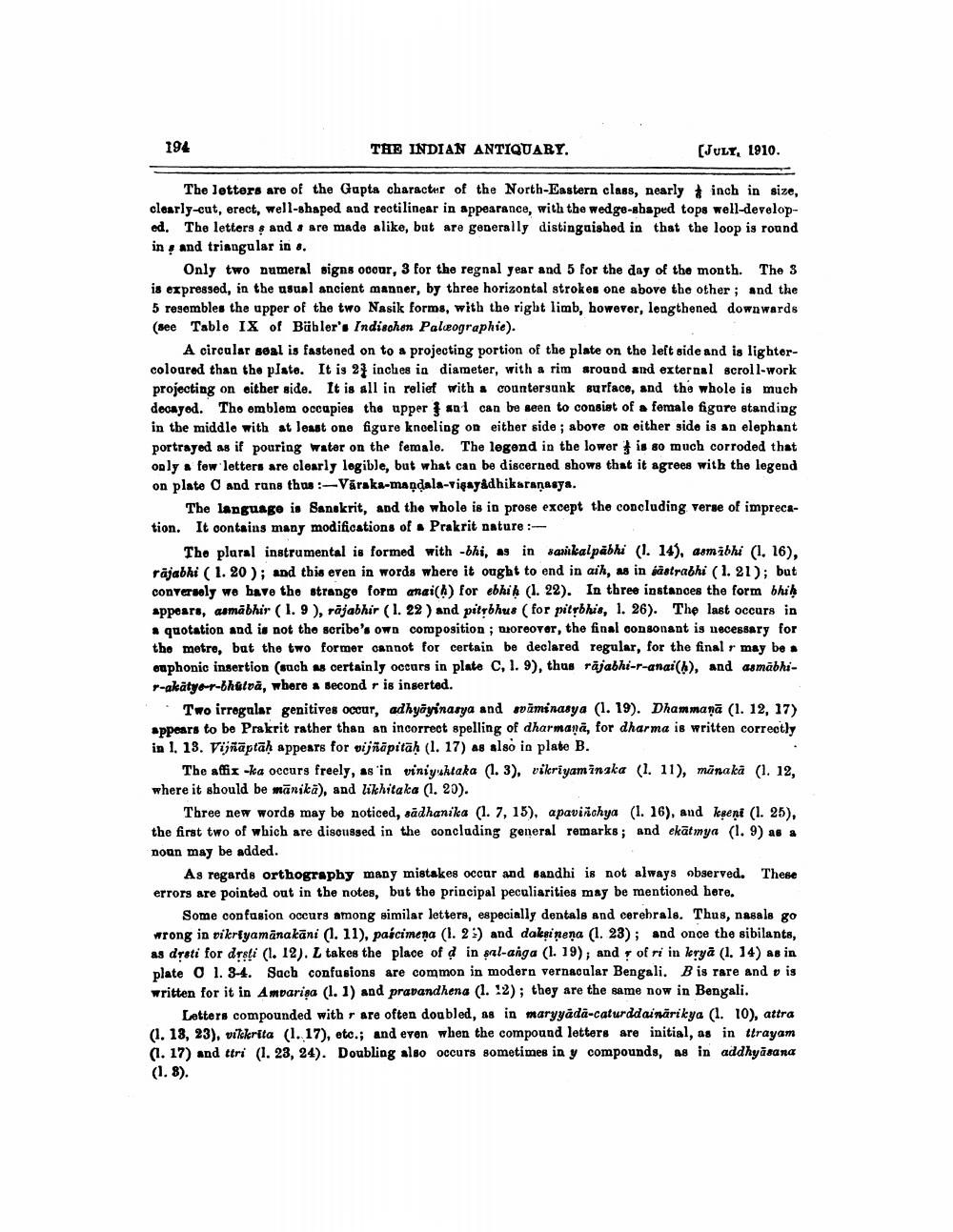________________
194
THE INDIAN ANTIQUARY.
(JULY, 1910.
The letters are of the Gupta character of the North-Eastern class, nearly #inch in size, clearly-cut, erect, well-shaped and rectilinear in appearance, with the wedge-shaped tops well-developed. The letters and are made alike, but are generally distinguished in that the loop is round in and triangular in s.
Only two numeral signs odour, 3 for the regnal year and 5 for the day of the month. The S is expressed, in the asual ancient manner, by three horizontal strokes one above the other; and the 5 resembles the upper of the two Nasik forms, with the right limb, however, lengthened downwards (see Table IX of Bäbler's Indischen Palæographie).
A circular soal is fastened on to a projecting portion of the plate on the left side and is lightercoloared than the plate. It is 27 inches in diameter, with a rim around and external scroll-work projecting on either side. It is all in relief with a countersunk surface, and the whole is much decayed. The emblem occupies the upper sol can be seen to consist of a female figure standing in the middle with at least one figure knoeling on either side ; above on either sido is an elephant portrayed as if pouring water on the female. The legend in the lower is so much corroded that only a few letters are clearly legible, but what can be discerned shows that it agrees with the legend on plate 0 and runs thus :-Váraka-mandala-viqayadhikaranasya.
The language is Sanskrit, and the whole is in prose except the concluding verse of imprecation. It contains many modifications of Prakrit nature :
The plaral instrumental is formed with -bhi, as in sarikalpabhi (1. 14), asmibhi (1. 16), rajabki ( 1. 20); and this even in words where it ought to end in aih, as in sastrabhi (1. 21); but conversely we have the strange form anai(A) for ebhik (1. 22). In three instances the form bhih appears, armabhir (1.9), räjabhir (1. 22 ) and pitsbhus (for pitsbhis, 1. 26). The last occurs in . quotation and is not the soribo's own composition ; noreover, the final consonant is necessary for the metre, bat the two former cannot for certain be declared regular, for the final r may be. euphonic insertion (such as certainly occurs in plate C, 1. 9), thus räjabhi-r-anai(b), and asmābhir-akátyo-r-bhatva, where a second r is inserted.
Two irregular genitives occur, adhyāyinasya and wiminasya (1. 19). Dhammanā (1. 12, 17) appears to be Prakrit rather than an incorrect spelling of dharmana, for dharma is written correctly in 1. 13. Vijñāptāḥ appears for vijñāpitäh (1. 17) as also in plate B.
The affis -ka occurs freely, as in viniyhtaka (1.3), vikriyaminaka (1. 11), mānaka (1. 12, where it should be mānikā), and likhitaka (1. 20).
Three new words may be noticed, sadhanika (1.7, 15), apaviñchya (1. 16), and kseni (1. 25), the first two of which are discussed in the concluding general remarks; and ekātmya (l. 9) as a noun may be added.
As regards orthography many mistakes occur and sandhi is not always observed. These errors are pointed out in the notes, but the principal peculiarities may be mentioned here.
Some confusion occurs among similar letters, especially dentals and cerebrals. Thus, nasals go wrong in vitriyamanakāni (1. 11), pascimena (1.2) and daksinena (1.23); and once the sibilants, as drsti for drsti (1.12). L takes the place of a in sal-anga (1. 19), and of ri in leryä (1. 14) as in plate 0 1. 3-4. Such confusions are common in modern vernacular Bengali. B is rare and vis written for it in Amparisa (1.1) and pravandhena (1.2); they are the same now in Bengali.
Letters compounded with r are often doubled, as in maryyada-caturddainärikya (1. 10), attra (1.13, 23), vikkrita (1. 17), etc.; and even when the compound letters are initial, as in ttrayam (1.17) and ttri (1. 23, 24). Doubling also occurs sometimes in y compounds, as in addhyāsana (1.8).




